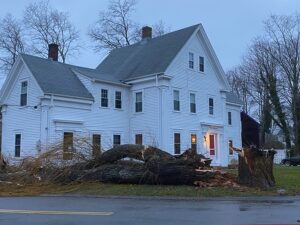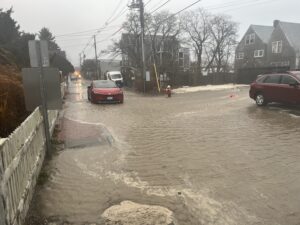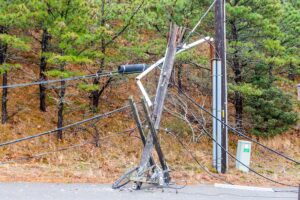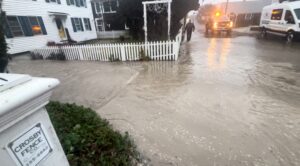PROVINCETOWN — The unnamed winter storm that dumped heavy rain on the East Coast on Monday, killing two people in Massachusetts and one each in New York, Pennsylvania, and South Carolina, caused a fresh round of coastal flooding in Provincetown’s East End. The storm came almost exactly a year after Winter Storm Elliott sent an even larger surge of seawater into the same areas on Dec. 23, 2022.

Provincetown Community Development Director Tim Famulare and Dept. of Public Works Director Jim Vincent drove around the East End at high tide that afternoon, when the National Weather Service was clocking wind gusts of 44 miles per hour. Winds from the south helped drive water above the 10.3-foot high tide that was forecast for 3:26 p.m. Videos and photos taken by Famulare and Vincent show seawater flowing across the Ice House Condominums parking lot and down Daggett Lane, retracing a path that flooding had taken only a year before.
There was much less water than last year, however, because the harbor did not reach the 13.8-foot level that it did during Elliott. According to the National Weather Service, the water in Provincetown Harbor rose to 12.67 feet at high tide on Dec. 18 — just below the “minor coastal flooding” metric of 13 feet.
As a result, seawater did not course all the way down Howland Street to Bradford Street, as happened last year.
Several homes along Commercial Street had their floorboards soaked, however. Seawater also intruded in the area of 541 Commercial, near Fanizzi’s restaurant and the Surfside Hotel, and around 599 Commercial, where at least one walkway between the street and the harbor flooded.
“It wasn’t as bad as last year’s storm, especially for the people who live on Howland Street, but it was still traumatizing for a lot of people to see this all playing out again,” said Vincent.
The wind fell off a bit just before high tide, Vincent said, and there was a half moon, so the tide was not as high as it could have been. The floods could easily have been worse, he said.

“The Ice House was the primary route of flooding this time, and it was less than last year at that site,” Vincent said. “I made a point of going before and after the storm to check, and while there was a trickle of water that went past the sandbag wall that was constructed at 509 Commercial, there was no scouring and no evidence of a running river of water there.”
The DPW had provided sandbags to neighbors of 509 Commercial Street just before the storm. They built a wall of bags across the rear of that property, which had been a conduit for floodwaters the year before.
Quinn Taylor, the neighbor who organized that effort, said he believed it had helped block some water.
“It was three feet tall, and it stayed up for about 94 percent of the storm,” Taylor said. “I thought we were going to make it through without getting flooded, and when I did see water coming across the street, it was from the Ice House, not that property.”
Taylor’s house sustained significant damage in last year’s storm. He is now waiting to find out if his kitchen floorboards, the underside of which were soaked, will need to be replaced.
Planning for Resilience
Only five days before Monday’s storm, Provincetown had held a public forum at which the Coastal Resiliency Advisory Committee had presented its plans for next year. The town will be hiring a consultant in February to develop a comprehensive approach to coastal resilience.

“The consultant will divide the town into 10 sections and take a close look at each area to determine what kind of projects might be appropriate in each area,” Famulare said. “We want to see a prioritization of these projects as well as cost estimates.
“One of the main issues is going to be funding,” Famulare added, and to secure funding the town will need to know what it wants to build, when, and for how much.
“Beyond general preparedness, we want concrete examples of what homeowners can do for their property,” Famulare said. The consultant would also tell the town how it can change its bylaws and regulations so that “when property owners do make resilience improvements, they do it in an effective and consistent way.”
As the Center for Coastal Studies documented in 2016, Provincetown is not one large flood zone but an undulating terrain with a series of flood pathways. After the December 2022 flood, the lead scientist on that study, Mark Borelli, said that a FEMA-required elevation of the home at 509 Commercial St., which sits in one of those pathways, could have lowered the ground level at that site.
Famulare said the consultant will explore funding sources for “community-scale” protection — that is, improvements that could protect entire blocks or small neighborhoods from flooding.
“We’ve had a lot of information in the last couple of years about things we can do to our property, and many of them are very expensive,” said Anthony Iannacci, a member of the historic district commission, during the public comment part of the forum. “What kind of action can we take collectively as a community to make sure that more of us are protected, as opposed to this every-man-for-himself mentality?”

“The town’s got to make some changes to its bylaws so that when you raise your building, you’ve got to put in a seawall,” said Sacha Richter, who said he owns property on Daggett Lane that flooded last year. “The more these houses lift, those of us a block behind are gonna get pummeled,” Richter said.
“We’re working with the Cape Cod Commission to develop regulations at the local level” that could be approved by a public hearing of the conservation commission rather than town meeting, said Famulare. “They have an engineering firm and a design consulting firm, and we’ve asked that they include ways to mitigate flooding if a property is elevated.”
There will be coastal resiliency public forums every two months next year, said advisory committee chair Michelle Stefani.
“This committee is geared toward taking everybody along for the ride so that when we do have a plan, it’s not news,” Stefani said. “Unless you’re engaged, it will seem a little severe, but we want to go step by step with the community and have full transparency.”



